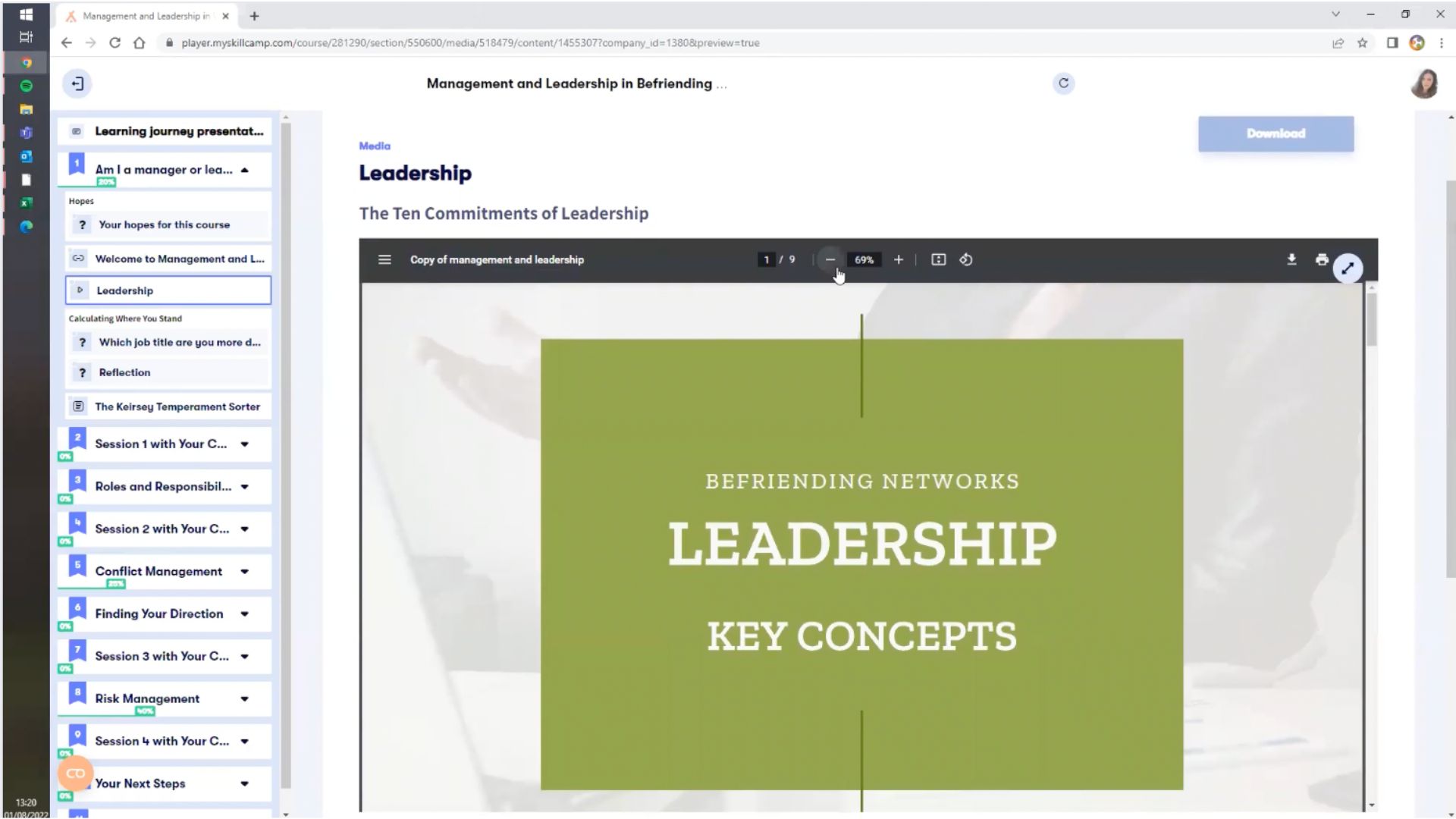We humans are easily distracted, quick to boredom and urr.... forgetful. This is a huge problem when it comes to creating courses for learners. After all, amazing things happen when your learners actually retain what they've learned.
Firstly it increases the return on investment, making the courses worth the expense. Secondly, the higher the retention of knowledge, the more those new skills are put into practise in the workplace. Thirdly, if one employee has a new skill they can teach their teammates, boosting knowledge sharing.
So check out these 10 effective methods to increasing the knowledge retention in your learners.
1. Weave in interactive elements
Ensuring your courses are interactive not only reduces boredom, but it makes learners active rather than passive in their learning. Adding quizzes, video chats, and group activities encourage learners to pay attention, use what they've just learned, and apply it in realtime. This is one reason why so many companies are using gamification tactics to improve their courses.
Not only does it encourage knowledge recall, but it's fun - and if something is fun you have a far better chance of remembering it. This is also why many training companies are taking advantage of multimedia. Remember the excitement you felt when the teacher would wheel the TV into the classroom? Elements like video, audio, VR and storytelling hold our attention for far longer, so use them in your courses.
2. Retell the story in different formats
Explaining a topic in one way only gives a very 2D view of that topic. It makes it much harder for learners to apply that topic in real world situations. Imagine a trainee surgeon only reading how to perform heart surgery before sending them to the operating theatre. *Shudder*
It's important to flesh out a topic by explaining it in different ways. Would including a chart, video, and a test be more helpful than a mere presentation? Definitely!
Another reason to retell a topic is to include all learner types you will have. Not everyone learns in the same way, so only giving them one format will be ineffective for at least 2/3 of the learners. Take into account the auditory, visual and tactile perspective when creating or adding to courses.
3. Make learning, micro
There have been many studies looking at the length of learning courses and the rate of concentration. In order to prevent cognitive overload it's important to make courses bitesized. Microlearning is highly popular in the eLearning world and focuses on small sessions covering a topic directly and using follow-up micro-courses to expand upon it. These small sessions give learners enough time to learn new information, while remaining short enough to prevent them becoming overloaded.
These microlearning courses also take advantage of multimedia, allowing learners to download, replay and save courses if they need a refresher.
This bitesize aspect of courses also translates to the design element of courses. Microlearning often looks clean and direct. If you want to create a short course, ensure the page isn't overloaded, the goal is clear, and you only say what needs to be said.
4. Include quizzes and exams throughout the courses
If learners know they are going to be tested on what they've learned, they will actively try to absorb and retain it, so they can recall it during the test. So including small, low-risk tests is highly encouraged. This can be another example of gamification as you may want to restrict access to the next level (course) until a learner reaches a certain score.
It can also be a great way of analysing your courses to see if they're perhaps too difficult, long, or unclear. If you notice a pattern of low scores, it could be the course rather than the learners' ability.
You can of course combine these elements by collecting the courses you like and creating a Learning Path.
5. Combine topics
Mixing up topics to give learners more variety, (or interleaved practise) is a great way to help learners retain information. It works by forcing their brains to recall different information and apply it to situations. After all, even an interesting topic can become stale if it's focused on too much, and learners will start to feel complacent in the fact they know information because it's the only thing they're learning.
Therefore, improve knowledge retention and introduce more skills into the mix by introducing learners to more than one topic at a time. For example, if you're teaching leadership, perhaps also include workplace conflict resolution.
6. Use stories and characters to create relatability
Storytelling has always been used to get small humans to remember things... turns out, big humans can benefit from it too! In fact, one of the myskillcamp, partners iAM Learning, prides themselves on creating animated explainer content that engages learners with its vibrancy and storytelling.
Storytelling works by making learners relate to characters and picture the specific skill being used in a scenario. By creating a relatable on-the-job situation you offer learners the chance to remember key concepts successfully.
Furthermore, storytelling, such as the kind created by iAM Learning uses video elements, which further engages learners. What can you create or buy that will do the same?
7. Encourage learners to use their newly acquired information
Apart from testing, (which we've already covered) we can encourage learners to use their newly acquired information in other ways. A great example of this is Blended Learning. After the eLearning portion of the course is complete, a video call or face-to-face meeting can be used to share what they've learned, ask follow-up questions, and role-play scenarios. This will not only encourage learners to pay attention to the previous part of the course, but it will help them recall information, build on their knowledge with others, and ask about aspects that they may not understand fully.
If not Blended Learning then perhaps give the learners a task on-the-job to perform, so they quickly put the information to use. Doing this will quickly make them masters of their new skill.
8. Create scenarios
Following on from point seven, creating scenarios that tie into real-world applications quickly show how this skill will be used in real life. Using the skill repetitively is the best way to store it in one's long-term memory, plus it helps the company ROI immediately.
Additionally, showing someone that a skill has relevancy in the real world encourages learners to take pay attention and appreciate the topic.
9. Lead them onto follow-up courses where the recent skill will be built upon
With any learner it's important to build a learning journey. Stopping after one topic will be demotivating to learners and won't establish a life-long learning culture within your company. However, following up with another course encourages learners to recall their previous knowledge and apply it to the new course. Moreover they will be motivated to pay attention to the courses they take, or they may struggle during the next one.
Build your learner journey in your LMS or learn how to build it with myskillcamp.
10. Set learning/skill goals
Increase knowledge retention by choosing courses that your learners are interested. During reviews and goal-setting periods, ask what they want to learn how how they want to progress in their career. Being motivated to learn will increase the likelihood they will retain information and progress steadily. This is also a great way to plan out a learner's journey.
Another bonus to this is that the learner will feel more motivated within their job as they are clearly being listened to and given a way to progress within the company. If it helps a learner achieve their Ikigai, it's going to improve your KPIs.
It may look like a lot of work, but if you already invest in eLearning and have a good LMS/LXP then you will find it easier to tick these boxes to create a high level of knowledge retention in your courses.
For example, myskillcamp lets companies build interactive courses and learner journeys in a user-friendly way. Furthermore, we have over 300,000 courses on our marketplace to enable companies to build upon their knowledge-base and offer more to their learners (as well as sell their courses).
If you want to see how much knowledge retention can be raised in your company then book a personalised trial with myskillcamp. It's time to improve your ROI.
Discover ten effective strategies to increase knowledge retention in courses, addressing common challenges such as distractions and forgetfulness.
















































































